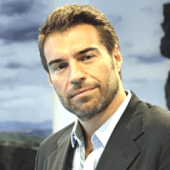What’s next for work with Microsoft’s Corporate Vice President of Modern Work, Jared Spataro
IN BRIEF
- 4:50 - We need the equivalent of a digital fabric that binds the organization together. That used to be a visionary statement. It’s not a visionary statement any longer. My employees expect to be able to work from anywhere, and I’m never going to have all of them back in the same physical space again.
- 9:40 - A high percentage of employees say that they feel very comfortable in digital spaces, and they’re ready for more innovation. Companies are still not quite sure what to make of all of this, so it’ll be interesting to see it play out.
- 19:50 - I like to start with the moment. If I have a chance to speak to someone who has decision-making authority at any level, I like to emphasize that this is literally a once-in-a-generation moment.
Protiviti’s Joel Hammer, Managing Director and Microsoft lead, sits down with Jared Spataro, Corporate Vice President of Modern Work at Microsoft to discuss the future of work in 2030 and beyond. In his role, Spataro leads Microsoft’s Modern Work team, which is dedicated to helping every person and organization navigate the shift and adapt to the new world of work. His team is driving research to help predict and shape what the future of work will look like across industries while also delivering new products and features within Microsoft 365 that will enable everyone to thrive.
WHAT’S NEXT FOR WORK WITH MICROSOFT’S CORPORATE VICE PRESIDENT OF MODERN WORK, JARED SPATARO - Video transcript
Joe Kornik: Welcome to the VISION by Protiviti interview. I’m Joe Kornik, Editor-in-Chief of VISION by Protiviti, our content initiative where we examine big topics that will impact business, the C-suite and executive boardrooms worldwide over the next decade and beyond.
Today, we’re exploring the future of work, and we have a wonderful guest to help us to do that in Jared Spataro, corporate vice president of modern work at Microsoft. In this role, Jared leads Microsoft’s Modern Work team, which is dedicated to helping every person and organization navigate the shift and adapt to the new world of work. His team is driving research to help predict and shape what the future of work will look like across industries while also delivering new products and features within Microsoft 365 that will enable everyone to thrive. For this one, I’m happy to turn over the interviewing to my colleague, Joel Hammer. Joel is a Protiviti managing director and Microsoft lead. Joel.
Joel Hammer: Thanks, Joe. We’re excited to be here. I’m looking forward to our discussion today. Jared, again, I appreciate you taking time to meet with us today and discussing the topic of the future of work, and specifically, we’re looking about 10 years out. This is a vision piece for us that we like to do and focus in this area. First question here, Jared, is, we thought by now that we’d be past this point, but unfortunately, we have to start with the COVID-19 question and there are positive horizons on the forefront, but it’s been two years now since the disruption. I know that Microsoft has used this unprecedented time in terms of learning. What are your biggest takeaways, and how it impacted work? What do you think that legacy will be, and how do you think the last two years will shape the next 10?
Jared Spataro: A really good set of questions. I’m glad we go all the way back to COVID-19, because my experience now has been after looking at so much data in different ways, you do have to go back down. What I mean by that is the following: Going into the pandemic, the thing that I never would have guessed about the way this would have changed work is that it’s changed the people that work. In other words, what the data seems to point to—ours and many other studies that I’ve seen—is that the people who are going back to work here as we come out of the pandemic are not the same people that used to go to your office. They’re totally different people.
In some cases, we’ve hired at lot. At Microsoft, as an example, we hired about a third of our company. We’ve had that much turnover over the two years. Even if you take the same workers, they have changed in the way they perceive life and the things that they value. The research that I’ve seen indicates that there’s a rethinking of the why of work: What role does work play in my life? Ultimately, the shared experience that we’ve had is going to be every bit as impactful as the Great Depression was on my grandparents, my great-grandparents, as an example, as the world wars had shaped the way people think.
We’re seeing that play out already right now in that people are rethinking things like well-being. They’re rethinking work-life balance. They’re thinking differently about geography and work. Two years of being able to work away from the office—for information workers, at least—has them thinking differently about what they must go into an office for. There are a lot of changes that we have seen psychologically for workers, and that’s going to be the lasting impact. We’re going to see those psychological changes—even many that we don’t recognize right now—play out over the next decade in the labor market, and those shifts in the labor market are going to show up in the office. We can talk more about that, but that sets the table for what I believe will be the lasting and the most durable impact of what we’ve experienced.
Hammer: Great input there, Jared. I agree with you. We’ll come back to some of those topics here in a couple of questions, because I think you set some great points there. The pandemic accelerated several of the trends that were already in motion. We look at hybrid. We look at remote work with teleconferencing, collaboration, software. We think specifically of Teams and Viva and Loop and others. How do you envision organizations continuing to incorporate some of the most successful pandemic strategies in the future?
Spataro: Well, I’m biased on this one, you know. Full disclosure: It’s my job to sell technology, so I have a technology perspective. The most common trend I see coming, on the technology front, out of the pandemic is this idea that leaders across the world and organizations of all sizes have realized, “We need the equivalent of a digital fabric that binds the organization together.” That used to be a visionary statement: “Let’s paint a picture of this digital fabric through space.” It’s not a visionary statement any longer. It’s simply this: My employees expect to be able to work from anywhere. I’m never going to have all of them back in the same physical space again.
How do I create an environment where we can keep on working, keep on being productive, move the ball forward regardless of where people are physically and regardless of where they are in a time continuum as well? That’s what we’re seeing across time and space: Those changes were creating new patterns. As I think about how to create that underlying digital fabric, Teams is our answer here at Microsoft. We think we’ve got a winner in that we’ve combined different workloads—chat, meet, call, collaborate, automate—into a single platform. We’re trying to build on top of that fabric, and many companies, even if they don’t choose Teams, are going to have to do same thing. They’re going to have to figure out, “How do I connect everybody from my frontline workers all the way up to the executive suite so that we’re operating together?”
What I call the increased clock speed of business will demand this. You just can’t wait for the water to get to the end of the row with paper-based or even email-based processes. You’re going to have to speed up the clock speed of your organization, so that’s how it will start to play out, and then, there’s still a lot for us to learn.
Hammer: Great input there. Coming from a farming background, I understand the water getting to the end of row there, Jared. As we look at Teams, we’ve had a lot of success as a firm with Teams and implementing them at our and clients for ourselves. We’re hearing about metaverses. We’re hearing about virtual spaces. Can you talk about the potential of mixed-reality capabilities such as metaverses and virtual spaces inside of Teams?
Spataro: I’m very happy to hear that’s all the buzz right now, for sure. Let me start, even before answering the specifics on what people had considered to be a metaverse application or not, and just say, we should pause for a moment and recognize that over the last two years, we have all operated not in physical spaces, but in digital spaces, at least. We’ve gotten work done, in at least the information worker context, through these shared digital spaces that are pretty miraculous.
I was pausing the other day and thought, “What if the pandemic would have hit even five years before—certainly, 10 years before?” We wouldn’t have had the technology to keep things going the way that we have. It would have been a very different picture. Then, if you start there and say, “We have been operating in a digital format, or in a digitally shared space. Where is this going?” That is where, at least, in the business context, the metaverse picks up.
We see three specific click stops of metaverse coming into these digital spaces. The first will be the increased use of avatars. We’ll see this in Teams here over the next few months—we’ll be adding avatars into Teams so that you can choose not just to have your camera on or off but also to choose to have a digital representation of yourself. That may seem like sci-fi. Our work in what we call our Human Factors Lab seems to indicate that this will have some amount of virality to it. People, when they see others using these avatars, start to recognize that there’s value. That’s one thing.
The second thing that we’ll see is the adoption of what I call augmented reality scenarios. This is where we’re bridging the physical and the digital in a way that helps people get tasks done, at least in the business context. We’re already seeing these types of things. We see teams integrated, for instance, in the helmets—that’s putting a clear glass onto which we can project different images, and then, ultimately, if you use something called HoloLens, we’re able to project onto reality digital figures, whether that’d be objects or markup.
This is going to be a very fast-follow part of the metaverse because of real value for customers here. We see them using it in manufacturing-type scenarios. We see them using it in field service-type scenarios. It’s just so much more practical to bring in an expert from thousands of miles away and have them literally work on the reality that’s right in front of you by diagramming things out and teaching you what you need to do. We’ll really see that as kind of a fast follow-on to the avatar space.
Then, finally, we’ll move into more virtual reality immersive spaces. That will be a thing. In many ways, we’ll see companies experiment with that. We’ll see our most forward-leaning customers who will pick those things up, but they’ll be doing it because it will be a way for them to start to create a deeper connection between people. There’ll be a real business purpose behind them, as opposed to just being used because they’re eye candy or neat, and so we’ll see it play out. I do think you should get ready. We have some data from a recent survey we’ve done that shows that employees are quite ready. A high percentage of them say that they feel very comfortable in digital spaces, and they’re ready for more innovation. Companies at large are still not quite sure what to make of all of this, so it’ll be interesting to see it play out.
Hammer: I know I’m certainly very interested and excited for that, to see those things. We’ve done a few things at our firm with avatars and leveraging those to train and put real-world examples in, and it’s amazing how once you get into that scenario, it’s real. You shut everything else out, and you’re in a real space, and so I’m looking forward to being able to take more of that.
You talked a little bit ago about Microsoft and hiring almost a third of your company over the last two years. As we start talking about talent, we’re seeing that there are talent shortages out there on the horizon, or even today. Maybe it’s overused, but we hear “the Great Resignation,” and that’s coming on. Those two seem to create somewhat of a troubling combination. In your opinion, what will organizations need to be aware of in shaping their workforce of the future? What skills and capabilities will be in the highest demand? How do you see artificial intelligence playing in that space?
Spataro: Those are some great questions. Let me give the source of a lot of what I’ll reference over the next minute or two as I answer. We have been doing a number of different studies, our broader space studies. It’s something we called the Work Trend Index. That’s a study where we go out and ask a battery of questions to 30,000 people across 31 countries to try and a get sense for their perceptions, their experiences, and then we follow that up with smaller pollster base, between 9,000 and 10,000 people, on special topics. That’s where some of what I’ll tell you is coming from.
As I think about this, it’s important to start with the fact that people have changed. In particular, the why of work has changed. You can translate that economically into a worth-it equation for every individual. They’re trying to figure out what makes it worth it for me to work for you or to sacrifice what I do and give you my time in exchange for what you’re going to give me in terms of compensation. That equation has changed and is still changing.
What we see companies or what we see individuals telling us is that more than ever before, they value, for instance, culture and values among organizations, and that’s a factor of the rising generation where that has been more true even pre-pandemic, but also of how people have felt and how they have changed over the course of the pandemic. We have not only seen culture and values become a big thing, but in general, we have also seen how a company gets its work done. We see people commenting on what type of technology is chosen and what that seems to indicate about the thinking or the mental models of an organization. That’s certainly coming out even already in the press as a thing.
Speaking more broadly, as I think about where companies are and what new skills are required, I will characterize it into two sections. First, for leaders, there’s a new set of skills that are definitely required. These skills not only are in digital skills—that’s a given—but leading in this day and age, at this moment, I think also requires a lot of empathy. It requires an ability to use culture to shape and drive outcomes perhaps as effectively as some of our predecessors who used the process in the ’50s, ’60s and ’70s. It requires an understanding of the psyche of people, the cultural context in which we live.
It is a brand-new environment. Every leader has to be an incredible communicator in new formats, in new media. As you think about those skills, that is a profile for a new type of leader. That’s the first category. Then, for workers themselves, employees themselves, there are a whole number of new technologies that you have to learn how to master. You have to learn how to not just use Word, Excel, PowerPoint, but you have to be fantastic at videoconferencing. You have to be adept at using chat and understanding the etiquette that goes with that. You have to be able to put it all together for real-time and asynchronous collab. There’s a whole bunch of new skills that will be emerging, and new etiquette.
One last thing I’ll leave with you on this is running a hybrid meeting where some people are online, some people are together with you—the most basic things: Who do you look at? How do you look at them? How do you make sure you get input from everyone? Those types of skills, we’re all going to need to learn together as we put work back together and move into physical spaces again.
Hammer: That’s great. Jared, you mentioned there about the leadership and some of the important talents and skills that they’re going to need to have. We saw where you had shared recently how companies are needing to be more proactive in that space and planning for what you talked a little bit about today. Some have created strategic C-level positions specific to the future of work. Do you think that’s the next executive role to emerge, and if so, where are those leaders coming from?
Spataro: We definitely see it. There’s data on LinkedIn that indicates that the future of work is not only a topic that’s being talked about, but there are also job titles out there that are increasingly using that phrase. We see hybrid being used increasingly. I think there’s an over 300% increase over the last few months of the word hybrid in things like job postings—all of these things that we’re feeling are making their way into the labor market. It’s good to have someone who’s thinking about the future of work.
If I’m honest with you, if I have a chance to sometimes meet CEOs and their directors to talk about these issues, I think it’s fine. If somebody wants to appoint someone on a senior leadership team to do that work, it’s good, but what I would tell them is, “You can’t escape the fact that reshaping your entire operating model, that rethinking your culture, is the job of the senior leadership team. You can’t delegate that to one person. It’s only when you wrap your head around that truth that you’re going to be able to do right.” With all this technology, with all this change, it is not a given that this is all going to go well. It’s going to take real leadership.
Now, I’m positive about the future. I’m optimistic about the future, that we can get it right. But instead of delegating it to people in your team, I encourage leaders to take it head-on and recognize that they should roll up their sleeves and not be afraid to tell people they don’t quite know, but are very willing to get in there and learn as they go.
Hammer: Yes, I agree with that. As we look out there, we are in that market of placing resources with different organizations and have a significant vision into that. It seems, as we look at the gig economy and networks of more nimble and collaborative teams, that that’s going to be what the future is going to look like. From your perspective, how do we get there with those teams and current talent models? It seems they don’t do it today. As we look through that, what are the things that you’re seeing with teams and individuals in the important skill sets that they’re going to need to be successful as we look out into the future?
Spataro: Increasingly against the backdrop of that faster clock speed that we talked about in just about every industry, competition is more fierce. Cycle times are shorter. That sets the stage for what we’re doing. We are increasingly seeing, at least in our research, what we call more adaptive teaming. This would be this idea of bringing together cross-functional teams, whose job it is to solve a problem end-to-end. You need experts, because you need so much depth in domains, but then, you need a way to put that together into a synthesized solution, as opposed to, “Here’s what marketing, here’s what research, tell me. Now, we’ve got to figure out what to go and do for real.” That is definitely becoming an emergent pattern.
You’re right. It’s not just that one part of our overall work system doesn’t support that. Talent models don’t support it, but the labor market isn’t quite there. Our systems in place to pay people and bring people on, our IT systems, and all of these things are going to need some work. The way we think about it is simply this: The future, if I could choose one word to say, “This is what the future is all about,” it would be flexibility. It’s flexibility in how you work. It’s flexibility in when you work. It’s flexibility in where you work. Today, a lot of the focus in the media, at least, is on where. We’re all talking about going back to the office and what that will look like, but you’re hitting on the point of how you work will be just as important.
This is part of that reprogramming of the operating model. We need to think about the agility that they want to program in. Now, the good news is, we can see from our analysis of things like telemetry that people are being able to get in touch with each other faster than ever before. This digital fabric allows them to, one ping, and I’ve got Joel, and I can quickly get the information I need from him, where previously, I might have needed to bump into him or find him or send him an email and wait for him to reply. We are finding ways to use the tools, but we’re going to have to put it all together.
I don’t have a satisfying answer that says, “Here you go—here’s how it’s going to work.” It’s really important for people to recognize that this new pattern of teamwork, this new pattern of getting work done, is a part of that “how,” and I would focus everyone on flexibility, recognize that that is going to be the keyword over the coming two to three years that will set the trajectory for the next 10 years.
Hammer: Great input there, and insight. There are going to be a lot of business leaders, board members that view this video. What’s your call to action to business leaders and board members? You’ve talked a lot about the culture. You’ve talked about making sure that they’re prepared, that they’re setting the turn there. What’s your call to these leaders? What should they be taking right now to make sure that they’re prepared when it comes to the future of work?
Spataro: I have to start with the moment, because the moment sets the tone for everything else. If I have a chance to speak to someone who has decision-making authority at any level, I like to emphasize that this is literally a once-in-a-generation moment. You have to recognize that. Your kids, and your kids’ kids, are going to look back on this moment just like we had looked back on the Great Depression and the world wars and say, “What changed?” With that in mind, then, if you hold the authority to shape culture, to think about structures and processes, you can’t take this as a moment of “Let’s get back to business. Let’s get back to how we were doing it.”
Instead, you need to think, “There could be winners and losers out of this.” In my particular setting, in my industry, what’s going to set apart those winners and losers? What are the key things—and there aren’t many—that are going to differentiate the people who emerge out of this situation stronger and performing better than everyone else? We have to go down by industry and perhaps by the competitive environment in a small cluster of companies to determine that. If you determine that as a leader, then you take that and turn that into a plan for your culture, a plan for your processes, a plan for your organizational structure. You put that together into a new operating model.
Simply put, recognize the moment. Get a plan grounded in the things that will make a difference over the long term, and then execute with alacrity. If you do that with real energy, people will recognize, “That’s a leader. She knows what she’s doing. He knows what he’s doing.” They will follow leaders who have that clarity of vision. It’s a rare opportunity.
Hammer: It really is to be game-changing, as you said, back where our grandparents and parents had back in the Depression, world wars, looking back on those things.
A final question here, Jared: As you look out to 2035—and we’re just shooting out here—we talked about a lot of things, but when you compare where we’re at today and you look out to 2035, what types of bold predictions would you make as it relates to the future of work?
Spataro: I’ve gotten one that I have a lot of confidence in. Presence, and how we project our presence to each other and share presence, is going to be become increasingly mediated digitally. That doesn’t mean that physical presence won’t be important. It will be, but we are going to get to the point where time and space matter less. They won’t not matter, but will matter less. We will have the tools to project presence so that with that presence, we can create real human connection. That’s the thing that has been missing. A lot of the commentary is that that presence is a means and the ends will be human connection, because all the great things we have done as a human family over the course of history have been done when we rallied together, when we bring the best and the brightest and the strongest into a unified sense of doing things, getting things done. All the things we’ve done that have been amazing had been done that way.
So, with presence mediated digitally, we’ll be able to create connections—new connections we’ve never had—and it will be that human connection that drives things. We’ll see holograms. We’ll see the ability to project ourselves into all sorts of physical and digital spaces, all in the name of getting that connection we need across time and space so that we can engage in some meaningful endeavors. We’ll look back and say, “It all started there. It started in 2020 with lowly videoconferencing as the beginning.”
Hammer: That’s fascinating, Jared. I was at one of the Microsoft partner conferences and saw where one of the CVPs over marketing who does a lot of marketing for Azure, I was impressed: She put a HoloLens on and stood back, and she introed, but then took a step back, and it projected a hologram, and the technology had learned the inflections of her voice, and she started her hologram, delivered her message, in perfect Japanese. I thought, “That is going to be cool,” and so I do. I look forward to those things, and the other things that we talked about today, and I really appreciate you taking time to meet with us. We’re excited about this as a firm, as, overall, people in the world to be able to experience this future of work. Truly, thank you for your time today.
Spataro: My pleasure. Thanks for having me.
Hammer: Back over to you, Joe.
Kornik: Thanks, Joel. Thank you, Jared, for those outstanding insights and that look into the future of work. I certainly enjoyed the discussion, and I hope you did as well. Thanks for joining us for the VISION by Protiviti interview. We’ll see you next time.
As Corporate Vice President of Modern Work, Spataro leads Microsoft’s Modern Work team, which is dedicated to helping every person and organization adapt to the new world of work. His team is driving research to help predict and shape what the future of work will look like across industries, while also delivering new products and features within Microsoft 365 that enable everyone to thrive.
Joel Hammer is a managing director in Protiviti’s global strategic account management group and serves as Protiviti’s Global Lead for Microsoft. In this role, he is responsible for overseeing all activities related to Microsoft and Protiviti’s Global Alliance with Microsoft. Hammer is a member of Protiviti’s Executive Team Advisory Council, driving strategic workstreams to support the achievement of the firm’s strategy.
Did you enjoy this content? For more like this, subscribe to the VISION by Protiviti newsletter.


























